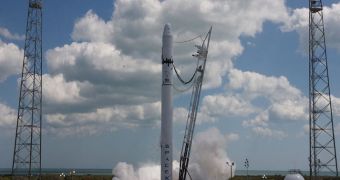Officials from Hawthorne, California-based Space Exploration Technologies (SpaceX) announce that their Falcon 9 medium-class delivery system has successfully completed its first test fire. The rocket is currently being prepared for its maiden flight on Launch Complex 40, at the Cape Canaveral Air Force Station (CCAFS), in Florida. The new test, which took place over the weekend, saw the nine first-stage Merlin engines on the Falcon 9 springing to life for a few seconds, just as they would during a real take-off. The success of this spacecraft is absolutely essential to ensuring that the United States maintain access to the International Space Station (ISS), if NASA retires its shuttles in September.
In the Saturday test fire, the Merlin engines sprung to life for about 3.5 seconds. If the engineers had kept them going for longer, then the entire rocket would have lifted off from its pad, and roared into space. SpaceX needs to demonstrate that this vehicle is capable of reaching orbit as soon as possible. It is under a $1.6 billion contract with NASA to carry out about 12 flights to the ISS for the next few years, and this entire program is dependent on this particular rocket. The capsule aboard the Falcon 9, called the Dragon, is to take supplies to the ISS, but it is also planned to undergo conversions.
SpaceX wants to have this spacecraft ready to carry astronauts to the orbital facility within two years. While it remains to be seen whether this actually happens or not, the idea is that there is a lot of stake in the successful launch of this rocket. Under President Barack Obama's new budget plan, the American space agency will receive some $6 billion over the next five years for supporting the private space flight industry, and companies such as SpaceX and the Orbital Science Corporation are believed to be the strongest candidates for the bulk of the funding.
“The test validated the launch pad propellant and pneumatic systems, as well as the ground and flight control software that controls pad and launch vehicle configurations. The completion of a successful static fire is the latest milestone on the path to the first flight of the Falcon 9, which will carry a Dragon spacecraft qualification unit to orbit,” SpaceX officials said in a statement. According to sources in the US Air Force (USAF), the spaceflight company is considering April 12 as a potential launch date for the new rocket. Though a date has not yet been fixed, it needs to launch the Falcon 9 between March and May, Space reports.

 14 DAY TRIAL //
14 DAY TRIAL //